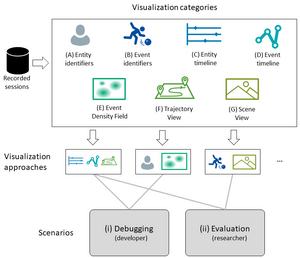The Research Group is Moving!
During winter term 2021/22, we move to University of Bamberg. From Oct. 15, 2021, Fabian Beck holds a full professor position on Information Visualization.
New webpage of the research group: https://www.uni-bamberg.de/vis
Publications
Publications of the research group since 2016. For earlier publications, please visit Fabian Beck's Google Scholar or DBLP profile.

Type of Publication: Article in Collected Edition
A Design and Application Space for Visualizing User Sessions of Virtual and Mixed Reality Environments
- Author(s):
- Agarwal, Shivam; Auda, Jonas; Schneegaß, Stefan; Beck, Fabian
- Title of Anthology:
- Proceedings of Vision, Modeling, and Visualization
- Publisher:
- The Eurographics Association
- Publication Date:
- 2020
- ISBN:
- 978-3-03868-123-6
- Digital Object Identifier (DOI):
- doi:10.2312/vmv.20201194
- Fulltext:
- A Design and Application Space for Visualizing User Sessions of Virtual and Mixed Reality Environments (1.35 MB)
- Talk associated with this publication:
- Vision, Modeling, and Visualization 2020
- Recording:
- https://www.youtube.com/watch?v=hUenXnU5Adk
- Citation:
- Download BibTeX
Abstract
Virtual and mixed reality environments gain complexity due to the inclusion of multiple users and physical objects. A core challenge for developers and researchers while analyzing sessions from such environments lies in understanding the interaction between entities. Additionally, the raw data recorded from such sessions is difficult to analyze due to the simultaneous temporal and spatial changes of multiple entities. However, similar data has already been visualized in other areas of application. We analyze which aspects of these related visualizations can be leveraged for analyzing user sessions in virtual and mixed reality environments and describe a design and application space for such visualizations. First, we examine what information is typically generated in interactive virtual and mixed reality applications and how it can be analyzed through such visualizations. Next, we study visualizations from related research fields and derive seven visualization categories. These categories act as building blocks of the design space, which can be combined into specific visualization systems. We also discuss the application space for these visualizations in debugging and evaluation scenarios. We present two application examples that showcase how one can visualize virtual and mixed reality user sessions and derive useful insights from them.
